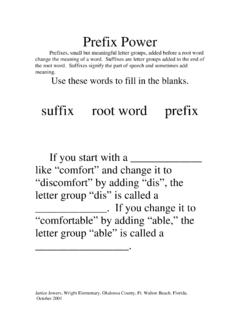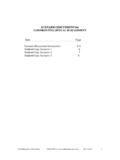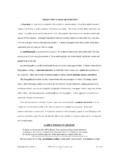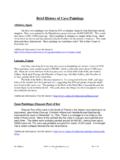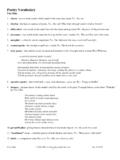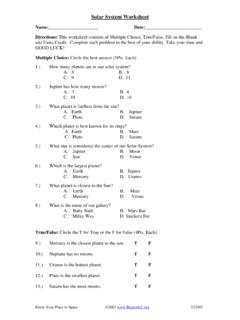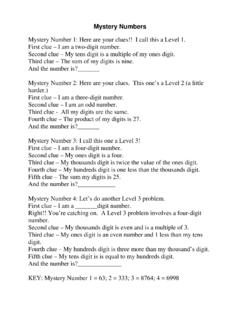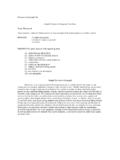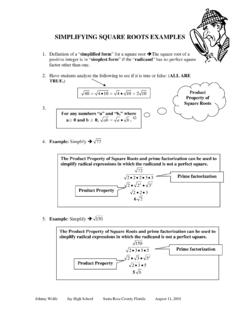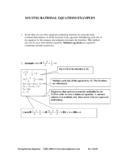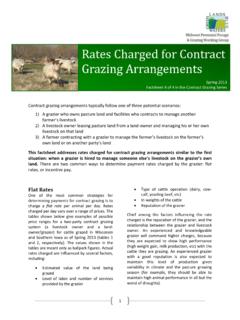Transcription of Ions & Their Charges Worksheet - Beacon Learning Center
1 Are You Charged? 2002, 2004 Rev. 1 Ions & Their Charges Worksheet Name _____ Date _____ Teacher _____ Diagram of Charges based on groups on the periodic table including transition metals and noble gases: IA IIA Transition metals IIIA IVA VA VIA VIIA VIIIA +1 +2 +2 +3 +4 or -4 -3 -2 -1 0 Diagram of Charges based on groups on the periodic table without transition metals, d block, and without noble gases, group VIIIA, to illustrate symmetry of the Charges : IA IIA IIIA IVA VA VIA VIIA +1 +2 +3 +4, -4 -3 -2 -1 The charge on an ion will involve a number and a sign. The number will always be the number of electrons involved, , loss of two electrons is +2. The sign will be positive if electrons, negatives, are lost and negative if electrons, negatives, are gained.
2 I. Determine the Charges on the following using the diagram above as a guide: 1. An atom having lost two electrons _____ 2. An atom having lost six electrons _____ 3. An atom having gained one electron _____ 4. An atom having gained three electrons _____ 5. An atom having lost five electrons _____ 6. An atom having gained two electrons _____ 7. An atom having lost one electron _____ 8. An atom having gained four electrons _____ II. Determine the Charges on the following elements based on Their locations on the periodic table using the knowledge gained during the Are You Charged? lesson: 1. Fluorine, F #7 _____ 2. Magnesium, Mg #12 _____ 3. Aluminum, Al #13 _____ 4. Sodium, Na #11 _____ 5. Nitrogen, N #7 _____ 6. Zinc, Zn #30 _____ 7. Hydrogen, H #1 _____ 8. Argon, Ar #18 _____ 9. Barium, Ba #56 _____ 10.
3 Sulfur, S #16 _____ Are You Charged? 2002, 2004 Rev. 2 III. Answer the following questions based on knowledge gained from the Are You Charged? lesson: 1. Will metals lose or gain electrons? Answer _____ 2. Considering your answer for #1, what type of ion will metals form, positive or negative? Answer _____ 3. What is the name of a positive ion? Answer _____ 4. What is the name of a negative ion? Answer _____ 5. How many electrons are contained in a completed outer shell for period 1? Answer _____ 6. How many electrons are contained in completed outer shells for all periods above period 1? Answer _____ 7. What is the charge on ions that is common to all elements of the d block, transition metals? Answer _____ 8. What is the charge on ions that is common to all elements of the f block, inner-transition metals? Answer _____ 9. What types of electrons, s, p, d, or f, are considered those involved in the make-up of the outer shells of atoms?
4 Answer _____ 10. What is the term used for a completed outer shell of eight electrons? Answer _____ 11. What is the only charge common to group IA elements? Answer _____ 12. What is the only charge common to group IIA elements? Answer _____ 13. What type of electrons, s, p, d, or f, are involved in ion formation of group IA and group IIA elements? Answer _____ 14. What does carbon, C #6, group IVA, form either +4 or 4 ions? Answer _____ 15. Why do elements in group VIIIA, noble gases, have zero, 0, as the charge that Their ions will form? Answer _____ Are You Charged? 2002, 2004 Rev. 3 Charges of Ions Test Name _____ Period _____ Teacher_____ I. Answer the following by placing the letter of the answer that best completes the statement or answers the question. _____ 1. What is the most likely combination of types of electrons that are involved in forming complete outer shells?
5 A.) s and p b.) s and d c.) p and d d.) p and f. _____ 2. The ion charge that is common to all transition elements is a.) +1 b.) +2 c.) -1 d.) -2. _____ 3. Metals form which type of ions? a.) negative b.) anions c.) cations d.) neutral. _____ 4. What is the most probable charge of the ions of elements located in group IIIA? a.) +1 b.) +2 c.) +3 d.) +4. _____ 5. What is the charge of an atom that has lost four electrons? a.) positive b.) +4 c.) negative d.) -4. II. Answer the following placing your answers on the spaces provided at right: 1. What is the charge on an atom that has gained one electron? 2. What is the charge of an atom that has lost three electrons? 3. What is the charge of elements in group VIA?
6 4. What is the charge of elements in group IA? 5. What is the most probable charge of an ion of fluorine, #9, group VIIA? Are You Charged? 2002, 2004 Rev. 4 6. What is the most probable charge of an ion of magnesium, #12, group IIA? 7. What is the most probable charge of an ion of sulfur, #16, group VIA? 8. What are the two Charges possible for elements in group IVA? 9. What is the charge common to all inner-transition elements, the f block? 10.
7 Which electrons, s, p, d, or f, are involved in the ion formation of Al+3? III. Draw an illustration similar to the one used in the Are You Charged? lesson, of the way phosphorus would form a 3 ion showing the nucleus Charges of protons and the electron cloud Charges of electrons. nucleus IV. Fill in the table with the correct Charges of the groups listed: Group IA Group IIA Group IIIA Group IVA Group VA Group VIA Group VIIA Are You Charged? 2002, 2004 Rev. 5 Ions & Their Charges Worksheet Answer Key I. Determine the Charges on the following using the diagram above as a guide: 1. An atom having lost two electrons +2 2. An atom having lost six electrons +6 3. An atom having gained one electron -1 4.
8 An atom having gained three electrons -3 5. An atom having lost five electrons +5 6. An atom having gained two electrons -2 7. An atom having lost one electron +1 8. An atom having gained four electrons -4 II. Determine the Charges on the following elements based on Their locations on the periodic table using the knowledge gained during the Are You Charged? lesson: 1. Fluorine, F #7 -1 2. Magnesium, Mg #12 +2 3. Aluminum, Al #13 +3 4. Sodium, Na #11 +1 5. Nitrogen, N #7 -3 6. Zinc, Zn #30 +2 7. Hydrogen, H #1 +1 8. Argon, Ar #18 0 9. Barium, Ba #56 +2 10. Sulfur, S #16 -2 III. Answer the following questions based on knowledge gained from the Are You Charged? lesson: 1. Will metals lose or gain electrons? Answer lose 2. Considering your answer for #1, what type of ion will metals form, positive or negative?
9 Answer positive 3. What is the name of a positive ion? Answer cation 4. What is the name of a negative ion? Answer anion 5. How many electrons are contained in a completed outer shell for period 1? Answer two 6. How many electrons are contained in completed outer shells for all periods above period 1? Answer eight 7. What is the charge on ions that is common to all elements of the d block, transition metals? Answer +2 Are You Charged? 2002, 2004 Rev. 6 8. What is the charge on ions that is common to all elements of the f block, inner-transition metals? Answer +3 9. What types of electrons, s, p, d, or f, are considered those involved in the make-up of the outer shells of atoms? Answer s & p 10.
10 What is the term used for a completed outer shell of eight electrons? Answer perfect octet 11. What is the only charge common to group IA elements? Answer +1 12. What is the only charge common to group IIA elements? Answer +2 13. What type of electrons, s, p, d, or f, are involved in ion formation of group IA and group IIA elements? Answer s 14. What does carbon, C #6, group IVA, form either +4 or 4 ions? Answer both 15. Why do elements in group VIIIA, noble gases, have zero, 0, as the charge that Their ions will form? Answer filled outer shells _____ Charges of Ions-Test Answer Key a 1. What is the most likely combination of types of electrons that are involved in forming complete outer shells? a.
